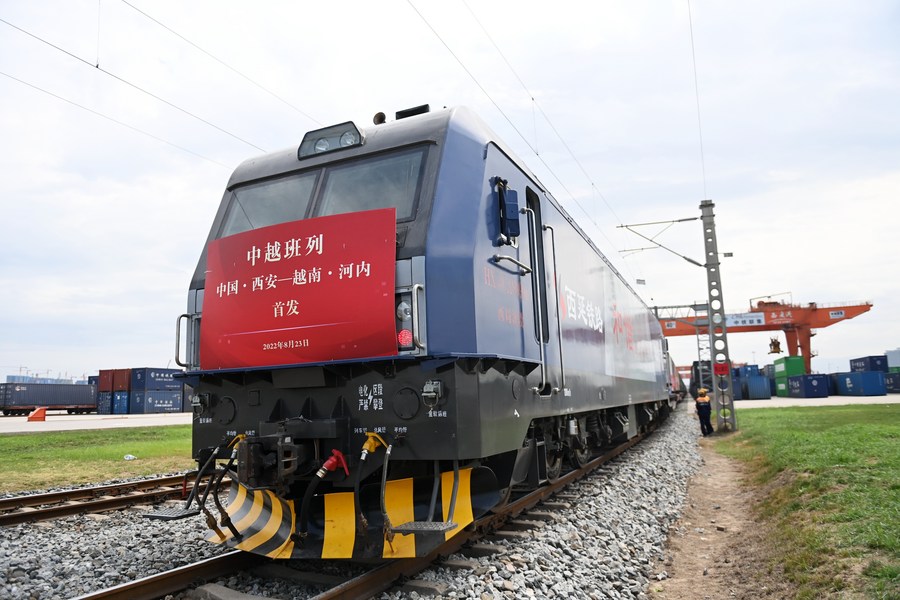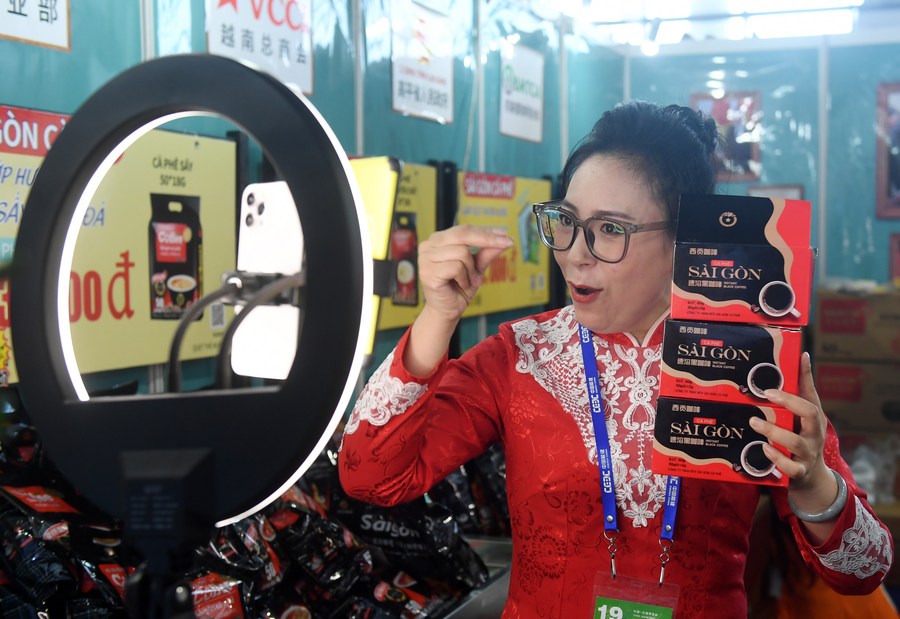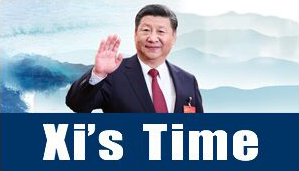
A China-Vietnam freight train pulls out of Xi'an international port in Xi'an, northwest China's Shaanxi Province, Aug. 23, 2022. (Xinhua/Li Yibo)
China and Vietnam are friendly socialist neighbors with shared ideals, the same social system and similar development paths. The shared future of the two parties, two countries and two peoples is closely bound up by the same social system and development goals.
BEIJING, Dec. 11 (Xinhua) -- After six years, Xi Jinping, general secretary of the Communist Party of China (CPC) Central Committee and Chinese president, will again pay a state visit to Vietnam at the invitation of General Secretary of the Communist Party of Vietnam (CPV) Central Committee Nguyen Phu Trong and Vietnamese President Vo Van Thuong.
The visit will not only consolidate and deepen the traditional friendship between China and Vietnam as friendly socialist neighbors, but also send a clear signal to the world to promote building a community with a shared future in the neighborhood.
Xi's visit will add new impetus to the Asia-Pacific region's stability, development and prosperity and inject more certainty and stability into a turbulent and intertwined world. It is indeed a journey to the past and the future.
A SHARED FUTURE
China and Vietnam are friendly socialist neighbors with shared ideals, the same social system and similar development paths. The shared future of the two parties, two countries and two peoples is closely bound up by the same social system and development goals.
In 2015 and 2017, Xi visited Vietnam twice as general secretary of the Communist Party of China Central Committee and Chinese president.
Those visits deepened the traditional friendship between China and Vietnam, promoted the development of socialism and injected strong impetus into regional and world peace and stability and building of a community with a shared future for mankind through promoting political party diplomacy and state-to-state exchanges.
In October 2022, Xi and Trong held historic talks in Beijing, jointly steering the development of China-Vietnam relations and drawing up a new vision for China-Vietnam comprehensive strategic cooperation in the new era.
China and Vietnam issued a joint statement on further strengthening and deepening the comprehensive strategic cooperative partnership, advancing the synergy between the Belt and Road Initiative (BRI) and the "Two Corridors and One Economic Circle" plan.
Looking back at history, China and Vietnam have supported each other in fighting for their respective national liberation causes and forged a profound bond of "camaraderie and brotherhood." The traditional friendship nurtured by the older generations of leaders of the two countries remains a valuable asset for developing relations between the two sides.
This year marks the 15th anniversary of the establishment of the China-Vietnam comprehensive strategic cooperative partnership. Xi's upcoming visit is expected to make greater contributions to consolidating the social foundation for the development of bilateral relations, realizing the stability and development of both countries and pushing bilateral relations to a new level.
Nguyen Van Tho, former Vietnamese Deputy Foreign Minister and former ambassador to China, said the continuous development of Vietnam-China relations is in line with the interests of the two peoples and the general trend of the times.
He is looking forward to Xi's visit to Vietnam and expressed anticipation for the two leaders to jointly draw a blueprint for developing Vietnam-China relations and initiate a higher stage of political trust.
LAY FAST LANE FOR DEVELOPMENT
China and Vietnam are both advancing their own socialist modernization cause, both regard the bilateral relationship as a priority in their respective foreign policy, and both see each other's development as opportunities for their own development, said Xi on Oct. 20 when he met with Vietnamese President Thuong, for the third Belt and Road Forum for International Cooperation.
China's continued expansion of high-level opening-up has brought Vietnamese companies great opportunities to access a bigger market.
TH True Milk Group's Chairman Thai Huong recalled how, at the inaugural China International Import Expo (CIIE) in 2018, "President Xi Jinping visited our booth, attentively inquiring about our products."

People visit the booth of Vietnam at the 6th China International Import Expo (CIIE) in east China's Shanghai, Nov. 6, 2023. (Xinhua/Fang Zhe)
Thanks to the CIIE, this Vietnamese dairy production company formed a connection with China. With the assistance of Chinese partners, TH True Milk Group became the first Vietnamese dairy enterprise in 2019 to receive a transaction code to export its products issued by the General Administration of Customs of China.
Today, the company's products are available on supermarket shelves in cities like Beijing, Shanghai and Guangzhou. At the same time, online stores have been established on various e-commerce platforms in China.
At the recently concluded inaugural China International Supply Chain Expo, Nguyen Thi Mien Ha, brand manager at Vietnam's SAO THAI DUONG Joint Stock Company, said that the Expo provides opportunities for companies to deeply integrate with the Chinese market.
China's ability to manufacture advanced products, along with its large market and efficient logistics system, makes it easy for global industrial and supply chain operations to function smoothly, said the manager.
China is Vietnam's largest trading partner, and Vietnam is China's largest trading partner within ASEAN, with bilateral trade exceeding 200 billion U.S. dollars for two consecutive years. In the first 10 months of this year, bilateral trade reached 185.1 billion dollars.
In 2017, China and Vietnam signed a memorandum of understanding on the joint implementation of the China-proposed BRI and Vietnam's "Two Corridors and One Economic Circle" plan to expedite cooperation across diverse sectors.
From booming border trade to infrastructure connectivity, from cooperation in industrial and supply chains to green development, practical cooperation between China and Vietnam has been expanding.
Vietnam's Vinh Tan Coal Fired Power Plant, one of the first projects under the BRI framework, has operated safely for over five years, greatly easing power shortages in southern Vietnam, with cumulative power generation exceeding 41 billion kWh. The plant has driven over one billion dollars of domestic engineering services, technology and equipment exports.
Another example of bilateral cooperation is Vietnam's first urban light rail, which was built by China Railway Sixth Group Co., Ltd., and has been operational for two years.
The line, starting from Cat Linh to Ha Dong in Hanoi, capital of Vietnam, has facilitated public transport for local residents and significantly contributed to Hanoi's economic growth.
As a landmark project aligning with the BRI and the "Two Corridors and One Economic Circle" plan, the line illustrates the commitment of both countries to a people-centered development philosophy.
Vietnam and China have additionally experienced advantages from the BRI's green energy cooperation.
According to Lu Hefeng, vice general manager of Ginlong Technologies Co. Ltd., a global provider of solar and energy storage solutions from China, Southeast Asian customers have shown a growing interest in green energy products made in China.
"We have established a factory in Vietnam with a capacity of 5 gigawatts," she said.
PROMOTING REGIONAL PEACE, PROSPERITY
On the morning of Oct. 16, two trains loaded with Yunnan specialties, including broccoli, Chinese cabbage and pomegranates, departed from the Yanhe Station in the city of Yuxi in the southwestern province of Yunnan.

Staff members label durians to be exported to China at a durian processing plant in Dak Lak province, Vietnam, Sept. 15, 2023. (Xinhua/Hu Jiali)
They arrived at the Laos capital, Vientiane, and Vietnam's Lao Cai a day later.
It marked the launch of the international cold-chain train services on the China-Laos and China-Vietnam routes, which will drive economic and trade growth and enhance connectivity within the China-Indochina Peninsula Economic Corridor.
In his meeting with Trong in October 2022, Xi stressed that China regards ASEAN as a priority in its neighborhood diplomacy and a critical region for high-quality Belt and Road cooperation. China values Vietnam's position and role in ASEAN, said Xi.
"We look forward to working with Vietnam to accelerate the building of a peaceful, safe and secure, prosperous, beautiful and amicable home together, and to promote regional economic integration in East Asia," he said.
Unremitting efforts are being made to build a closer China-ASEAN community with a shared future.
Regional cooperation has been enriched by two-way investment exceeding 380 billion dollars, setting a noteworthy example of collaboration between China and neighboring countries.
This year marks the 10th anniversary of China's practice of the principles of amity, sincerity, mutual benefit and inclusiveness in neighborhood diplomacy.
Over the past decade, China has catalyzed the development of neighboring countries through its own growth. In collaboration with neighboring countries, efforts have been made towards modernization and bolstering global development.
With negotiations accelerating regarding the China-ASEAN Free Trade Area 3.0, the dividends resulting from the signing of the Regional Comprehensive Economic Partnership are becoming evident.
China has also successfully hosted the China-ASEAN Expo, China-South Asia Expo, the China Import and Export Fair, the CIIE and the China International Supply Chain Expo.

A staff member promotes Vietnamese coffee products via livestreaming during the 19th China-ASEAN Expo at the Nanning International Convention and Exhibition Center in Nanning, south China's Guangxi Zhuang Autonomous Region, Sept. 19, 2022. (Xinhua/Lu Boan)
"We must remain steadfast in our commitment to APEC's founding mission. We must respond to the calls of our times responsibly and meet global challenges together. We must fully deliver on the Putrajaya Vision of building an open, dynamic, resilient and peaceful Asia-Pacific community for the prosperity of all our people and future generations," said Xi at the 30th APEC Economic Leaders' Meeting held in San Francisco, the United States.
Thong Mengdavid, a research supervisor at the Phnom Penh-based independent think tank Asian Vision Institute, said that China-ASEAN cooperation -- defined by the building of free trade zones, BRI cooperation, the Global Development Initiative, the Global Security Initiative and the Global Civilization Initiative -- will result in regional high-quality development and prosperous shared future.
Building an Asia-Pacific community with a shared future is needed for peace and development in the Asia-Pacific region today and provides new insights for growth, said Bambang Suryono, chairman of Indonesia's think tank Asia Innovation Research Center.
China prioritizes mutual growth and values collaboration that benefits all parties involved, he said.
(Xinhua reporters Tao Jun, Sun Yi and Hu Jiali in Hanoi, Gao Bo in Bangkok, Wu Changwei in Phnom Penh and Wang Ao'na in Jakarta contributed to the story.)■








